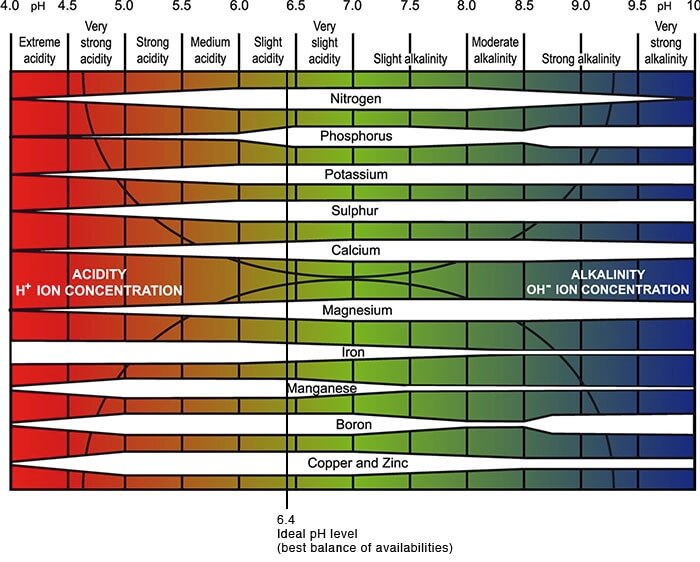
Agronomy
Topic
Understanding soil test reports
Following are some explanations of the various facets of soil and soil test results. First looking at CEC, TEC, pH and organic matter, as these are the main four categories outside the actual nutrient data that affect availability and make up a good soil report. A BioAg agronomist will provide an interpretation and explanation of all soil test reports. Please don’t hesitate to contact us if there are any areas of a soil test that require further explanation.
Cation Exchange Capacity (CEC)
Cation Exchange Capacity (CEC) offers an immediate guideline as to the nutrient and moisture storage capacity of your soil. A light sandy soil might have a CEC as low as 3, while a heavy clay soil might be as high as 60.
This is essentially a measure of the clay component of your soil, and it can also indicate the appropriate fertilising strategy. A light, sandy soil, for example, should ideally be spoon-fed via fertigation (if possible) because it is not capable of much nutrient or moisture storage.
The term “cation exchange capacity” refers to the fact that an exchange often takes place when a cation (a positively charged ion, e.g. calcium, magnesium, potassium or sodium) is removed from the clay colloid by the hungry plant. The plant must maintain an internal electrical balance so it releases a cation whenever it takes one on board.
There would be no sense in taking in one nutrient and spitting out another, so the plant releases the non-nutrient mineral, hydrogen, whenever it takes in a cation like calcium or potassium. Hydrogen is effectively exchanged on the clay colloid and this lowers soil pH, as hydrogen is the acid element.
Total Exchange Capacity (TEC)
Total Exchange Capacity effectively means that the percentage of the non-nutrient mineral, hydrogen, has been factored into the equation.
A good soil test must always feature a TEC reading. If not, there is a risk that the relative percentages of the other major cations, that together comprise “base saturation” may be misleading. Base Saturation will be covered in more depth later, but essentially it relates to the percentage of the major cations (bases) that are “saturated” on, or attached to, the clay colloid.
Without the inclusion of hydrogen in the mix, you can be misled into thinking that you have an adequate cation balance when, in actual fact, half of your clay storage might be the acid-forming, non food mineral, hydrogen, that has not been measured. If this were the case, the slice of the pie represented by percentages of calcium, magnesium, potassium and sodium becomes very different when factoring in the 50% dilution effect of all of that hydrogen.
In short, your CEC might look fine but you may actually have an empty fuel tank, and it is not apparent if Total Exchange Capacity (TEC) is not included in your soil test.
Soil pH
pH is a measure of the acidity or alkalinity of your soil. Soil pH has a major impact upon nutrient uptake.
Most minerals are most available to the plant at a soil pH of 6.4, so this is considered the ideal soil pH. Acidic soils will render some minerals less available and alkaline soils will also compromise nutrient uptake. Please see the diagram below highlighting this phenomenon.
An oversupply of hydrogen drives soil acidity, but hydrogen disappears from the equation when the soil pH is above 7 (neutral).
If you have inherited a high pH soil, driven by an excess of magnesium, or sodium, or both, then it is a good strategy to bypass the associated soil lockups via direct route into the leaf. In this case it is always a productive strategy to foliar spray iron, manganese and boron at least twice per season, as they are the minerals most impacted by high pH soils.
If your soil pH is 8.0, for example, it can be tremendously effective and profitable to compensate with foliar applications of iron, manganese and boron (in cereal crops, usually at the five leaf stage and again immediately before flowering).

Organic Matter
This may be the single most important parameter on your soil test. Organic matter, or humus, is the true essence of soil fertility. If you can work toward building organic matter in your soil, there are a multitude of profound benefits.
These range from improved water and nutrient retention and reduced soil loss (through erosion) to greater crop resilience, less need for chemicals and more fun in your farming enterprise.
Organic matter is the “great forgiver”. You can weather your way through all sorts of mineral imbalances and deficiencies in your soil, simply because the humus compensates for, and buffers against, most problems. The higher your humus levels, the larger your microbial workforce and the more successful your growing enterprise.
Cover crops, microbial inoculums, humates, compost, minimum-till, intelligent grazing strategies and reclaiming earthworm counts are some of the humus building strategies that can make farming more profitable and so much more fun.
When we comprehend these critically important monitoring tools, we take the guesswork out of nutrition, we take control and we are less likely to suffer the joy-killing ‘stress’ that can undermine our farming pleasure.

Recent Comments